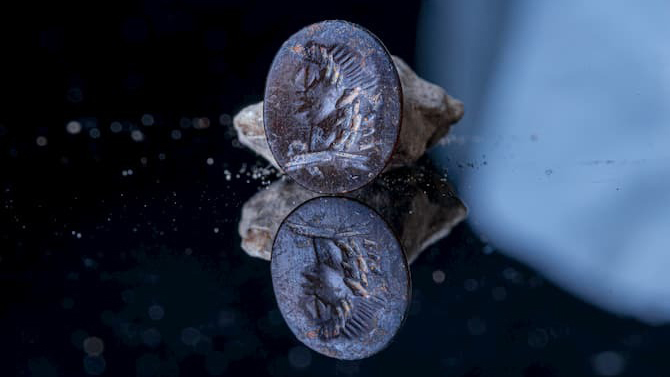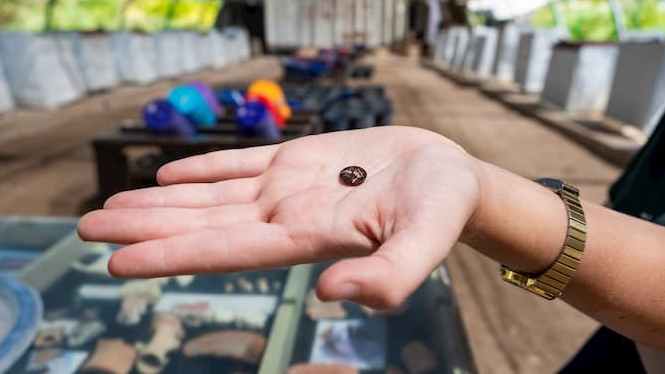2,000-year-old seal depicting Greek god Apollo found in Jerusalem
An ancient carved gem features a foreign god.

Archaeologists in Jerusalem have discovered a rare 2,000-year-old gem seal bearing the likeness of the god Apollo, but the gem's owner likely wasn't Greek or Roman, experts say.
Instead, this dark-brown jasper stone was likely owned by a Jewish person who lived during the first century A.D., and who was monotheistic but admired the qualities associated with Apollo, said Eli Shukron, an archaeologist with the Israel Antiquities Authority and a tour guide at the City of David archaeological park.
"I don't think he [the gem's owner] believed in the god Apollo," Shukron said in a City of David video (translated from Hebrew). "But he believed in the virtues that the god Apollo offered; light, purity, health, success, which are very, very positive attributes — very very conventional. Everyone wants to have them."
Related: In images: The largest stash of gold coins in Israel
City of David visitors, under the supervision of archaeologists, discovered the carved gem while sifting through soil that had once sat at the foundations of the Western Wall — the ancient remains of the retaining wall that once surrounded the Jewish people's Second Temple, which the Romans destroyed in A.D. 70.
The oval gem is smaller than a dime, measuring just 0.5 inches long, 0.4 inches wide and 0.1 inches thick (13 by 11 by 3 millimeters). This is only the third known gem seal of its kind, also known as an intaglio — a gem whose upper side is carved — from the Second Temple period (516 B.C to A.D. 70) in Jerusalem, archaeologists from the City of David said.

In antiquity, jasper was considered a precious stone. This particular carved gem was likely embedded in a ring, and used as a stamp on beeswax to serve as a personal signature on documents such as contracts, letters, wills, goods and bundles of money, according to City of David archaeologists.
Sign up for the Live Science daily newsletter now
Get the world’s most fascinating discoveries delivered straight to your inbox.
In the carving, Apollo's head is seen in profile, with his long hair flowing over a wide neck. The Greek and Roman god also has a large nose, thick lips and a prominent chin in the carving.
"It is rare to find seal remains bearing the image of the god Apollo at sites identified with the Jewish population," Shukron, who led the gem's excavation, said in a statement. "When we found the gem, we asked ourselves 'What is Apollo doing in Jerusalem? And why would a Jew wear a ring with the portrait of a foreign god?'"
"The answer to this, in our opinion, lies in the fact that the owner of the ring wore it not as a ritual act that expresses religious belief, but as a means of making use of the impact that Apollo's figure represents."

The sun god Apollo was "one of the most popular and revered deities in Eastern Mediterranean regions" at the end of the Second Temple period, Shua Amorai-Stark, an expert on engraved gems and professor emerita in the Art & Aesthetics Department at Kaye Academic College of Education in Beersheba, Israel, said in the statement.
"Among Apollo's spheres of responsibility, it is likely that association with sun and light (as well as with logic, reason, prophecy, and healing) fascinated some Jews, given that the element of light versus darkness was prominently present in Jewish worldview in those days." Amorai-Stark said. "The fact that the craftsman of this gem left the yellow-golden and light-brown layers on the god's hair probably indicates a desire to emphasize the aspect of light in the god's persona, as well as in the aura that surrounded his head."
Meanwhile, the decision to use a dark stone with highlighted light hair indicates that the creator wanted to emphasize the "aspect of light and darkness and/or their connectedness," she noted.
The Archeological Sifting Project was carried out in Tzurim Valley National Park, under the auspices of the City of David and the Nature and Parks Authority. Other findings from the sifting project include ancient coins, arrowheads and jewelry.
Originally published on Live Science.

Laura is the archaeology and Life's Little Mysteries editor at Live Science. She also reports on general science, including paleontology. Her work has appeared in The New York Times, Scholastic, Popular Science and Spectrum, a site on autism research. She has won multiple awards from the Society of Professional Journalists and the Washington Newspaper Publishers Association for her reporting at a weekly newspaper near Seattle. Laura holds a bachelor's degree in English literature and psychology from Washington University in St. Louis and a master's degree in science writing from NYU.










